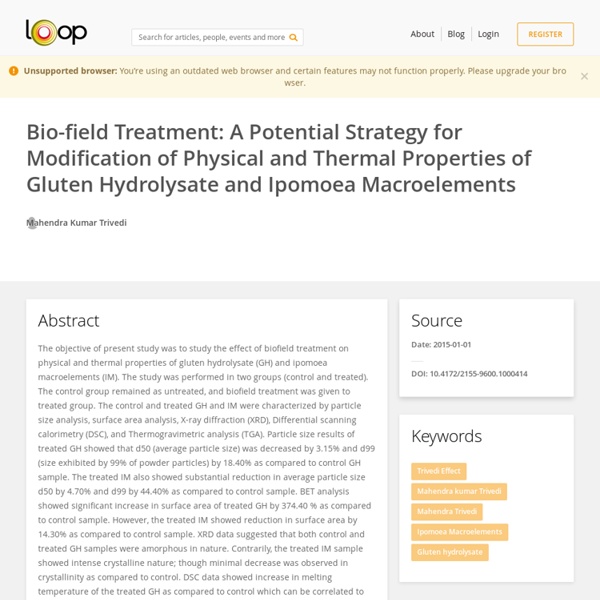



Biofield | Impact on Gluten Hydrolysate and Ipomoea Macroelements Open Access Research Article Analytical & Bioanalytical Techniques o u r n a l f y t i c e h q s Trivedi et al., J Anal Bioanal Tech 2015, 6:5 Volume 6 • Issue 5 • 1000265 J Anal Bioanal Tech ISSN: 2155-9872 JABT, an open access journal Keywords: Disulram; Nicotinic acid; Bioeld treatment; Fourier transform infrared spectroscopy; Ultraviolet spectroscopy Introduction Disulram [bis(diethylthiocarbamoyl)disulphide] is an antabuse drug, being used clinically as an aid to the treatment of chronic alcoholism. Administration to treat the alcohol addiction [1]. transforms into acetaldehyde by alcohol dehydrogenase enzyme, which further oxidized to acetic acid by acetaldehyde dehydrogenase (ADH) enzyme [2]. concentration of acetaldehyde increases and causes an unpleasant eect, thus increase the patient's motivation to remain abstinent [3]. addition to this, disulram is reported for protozoacidal eect in vitro study [4,5]. B3) that has cholesterol lowering activity. [7]. [10].
Modification of Gluten Hydrolysate & Ipomoea Macroelements Properties Title: Spectroscopic Characterization of Disulfiram and Nicotinic Acid after Biofield Treatment Publication: Analytical & Bioanalytical J Techniques Select license: Creative Commons Attributions-NonCommercial-ShareAlike Updated: November 19th, 2016 Abstract: Disulfiram is being used clinically as an aid in chronic alcoholism, while nicotinic acid is one of a B-complex vitamin that has cholesterol lowering activity. UV spectrum of control and biofield treated disulfiram showed similar pattern of UV spectra. Over all, the FT-IR and UV spectroscopy results suggest an impact of biofield treatment on the force constant, bond strength, and dipole moments of treated drugs such as disulfiram and nicotinic acid that could led to change in their chemical stability as compared to control.
Gluten Hydrolysate & Ipomoea Macroelements Properties – Read more Abstract Streptococcus agalactiae group B (S. agalactiae gr. B) is widespread in nature mainly causes bacterial septicemia and neonatal meningitis. Citation Information Mahendra Kumar Trivedi. Modification Properties of Gluten Hydrolysate & Ipomoea Macroelements <div class="c-box-warning full-width-element" style="text-align: center; "><div style="margin: auto; padding:10px;" class="container"><b>For full functionality of ResearchGate it is necessary to enable JavaScript. Here are the <a href=" rel="nofollow" target="_blank"> instructions how to enable JavaScript in your web browser</a>.</b></div></div> Abstract The objective of present study was to study the effect of biofield treatment on physical and thermal properties of gluten hydrolysate (GH) and ipomoea macroelements (IM). CitationsCitations0ReferencesReferences26 Data provided are for informational purposes only. An error occurred while rendering template. gl_zAhW8wSbUnWSSUxDa38oaALP rgreq-af58ad69fdb00a296e9d6504b1faddca false
Characteristic of Shigella sonnei after Biofield Treatment Abstract Shigella sonnei (S. sonnei) is a non-motile, rod shape, clinically significant, Gram-negative bacterium. It is commonly associated with dysentery (shigellosis). Tables at a glance Figures at a glance Mahendra Kumar Trivedi | Journal of Microbial & Biochemical Technology Abstract Streptococcus agalactiae group B (S. agalactiae gr. B) is widespread in nature mainly causes bacterial septicemia and neonatal meningitis. The current study was attempted to investigate the effect of biofield treatment on S. agalactiae gr.
Spectroscopic Characterization of Disulfiram & Nicotinic Acid - Study more Description Disulfiram is being used clinically as an aid in chronic alcoholism, while nicotinic acid is one of a B-complex vitamin that has cholesterol lowering activity. The aim of present study was to investigate the impact of biofield treatment on spectral properties of disulfiram and nicotinic acid. The study was performed in two groups i.e., control and treatment of each drug. Citation Information Mahendra Kumar Trivedi. Evaluation & Characteristic of Shigella sonnei after Biofield Treatment Citation: Trivedi MK, Patil S, Shettigar H, Bairwa K, Jana S (2015) Evaluation of Phenotyping and Genotyping Characteristic of Shigella sonnei after Bioeld Treatment. J Biotechnol Biomater 5: 196. doi:10.4172/2155-952X.1000196 Page 2 of 5 Volume 5 • Issue 3 • 1000196 J Biotechnol Biomater ISSN: 2155-952X JBTBM, an open access journal Based on the knowledge of existing literatures and considering the clinical signicance of S. sonnei, we evaluated to see the impact of bioeld treatment on antimicrobial susceptibility, biochemical reactions pattern, biotype number, and 16S rDNA gene sequencing of the microbe. Materials and Methods Two lyophilized vials of S. sonnei [American Type Culture Collection (ATCC) 9290] were purchased from MicroBioLogics, Inc USA. storage conditions till further use. biochemical reactions pattern, and biotype number were evaluated by MicroScan Walk-Away® (Dade Behring Inc., West Sacramento, CA) through Negative Breakpoint Combo 30 (NBPC30) panel. Bioeld treatment lyophilized).
Biofield Treatment on Streptococcus group B – Read more Citation: Trivedi MK, Branton A, Trivedi D, Nayak G, Shettigar H, et al. (2015) Effect of Bioeld Energy Treatment on Streptococcus group B: A Postpartum Pathogen. J Microb Biochem Technol 7: 269-273. doi:10.4172/1948-5948.1000223 Volume 7(5): 269-273 (2015) - 270 J Microb Biochem Technol ISSN: 1948-5948 JMBT, an open access journal bioeld treatment that is also called as Trivedi eect . unique bioeld treatment has been known to transform the structural, physical, and thermal properties of several metals in material science [12-14], improved the overall productivity of crops [15,16], altered characteristics features of microbes [17-19] and improved growth and anatomical characteristics of various medicinal plants [20,21]. Due to the clinical signicance of this organism and literature reports on bioeld treatment, the present work was undertaken to evaluate the impact of bioeld treatment on S. agalactiae group B in relation to antimicrobials susceptibility and bio typing based on (Dade Behring